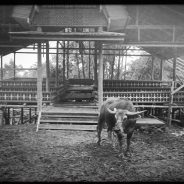
Uso de cookies
Este sitio web utiliza cookies para que usted tenga la mejor experiencia de usuario.
Si continúa navegando está dando su consentimiento para la aceptación de las mencionadas cookies y la aceptación de nuestra política de cookies.


3 July, 2017
80 year old, Ne Selpi, struggles to carry a bowl of rice and a coffee pot up the eight steps that lead to the interior of the Tongkonan, the house that precedes the rest of the buildings in the family home. Arriving next to her sister, she does the sign of the cross and with a soft voice says: “Norma. Wake up! Here’s your breakfast.” She leans over to place the food next to a coffin. This scene, as if it were from a film, takes place in a town in Tana Toraja, in the central, mountainous region of the Sulawesi Island, in Indonesia. Here, many families keep their deceased relatives in their homes for weeks, months, or even years after they die. Until the funeral ritual, a deceased person gets treated as a “to makula” – a person who’s ill, to whom one can talk to and feed symbolically.
Money and Social Class
The celebration of funerals can be delayed as much as needed until enough money can be saved to honour the person in a way that shows the social status of the family. The cost of these rituals can reach the thousands in Euros. As an example, the more water buffalos you can sacrifice and the bigger the funeral, the more you can display the family’s social status and economic prowess. A black water buffalo can cost around 2,400 Euros. But if you want an albino water buffalo, the price of these can oscillate between 13,000 and 45,000 Euros.
To this expense, you ought to add the cost of various pigs, rice, kitchen staff, that also double up as waiters, and the temporary structures that are erected to house and welcome the funeral attendees. It amounts to a fortune, especially if we have in mind that the minimum salary in Indonesia is that of 250 Euros per month.
Water Buffalo Fights
Today there’ll be water buffalo fights in Tobubun, they tell me at the hostel where I’m staying at. I need to get there quick. These water buffalo fights only happen when there is a big funeral and they attract a crowd, many in which take the opportunity to place bets and gamble some rupees.
With names written on their bodies with aerosol, the animals that are larger than 500Kg begin to be tugged from the sides until their heads clash and their horns become entangled. They begin to push each other in the mud, gasping, for the crowd’s joy.
It also happens that the animals can ignore each other completely and the uneasiness in the crowd quickly sets in. Or maybe one of them chases the other and with their speed and power they break through the bamboo fencing. The weak fencing then gives way for the animal to run into groups of people that run away from it, exciting the crowds again.
The animals are scared, running for their lives, but they are unaware that their next public appearance will be at the funeral, where their souls will begin to accompany that of the deceased person.
Sacrifice
It moves among the heads of others that lie lifeless. The one in charge of the slaughter raises his arm and, forcefully, pulls the rope that is tied up to the nose ring. With a skilled move, the knife cuts a deep wound in the water buffalo’s neck. This time is an albino one. Its first reaction is to try to let it self break free. The slaughterer, in the meantime, keeps the rope tight and the knife in the air.
It keeps bleeding, but its strength keeps trying to let it escape. It wants to run, but it tumbles. It stands but moves as if it was drunk. It’s hooves step on its own blood. It tries to breath, but the air isn’t reaching its lungs. It escapes from a hole in the trachea. It falls on the mud. Its head now looking up to the sky. It falls again, the last time, over a puddle of blood. Its body now rigid. The people celebrate, scream, laugh and enjoy the spectacle. It records it. The ritual now over, silence reigns in.
Procession and the Final Resting Place
I walked into the place of a funeral ceremony where I hear a protestant pastor giving the eulogy in honour of the deceased. With the ceremony over and after lunch, a group of family members will take down the coffin from the Lakian, a structure that housed the coffin and from where the ceremony was held. Two long bamboo sticks are tied up to it and the procession to the final resting place begins. On the way, those that carry the coffin will sing, tug it from side to side and, when near a paddy field, will jump into the water and play around. A festive feeling akin to a carnival rather than a funeral. This is happening while others in the procession cry.
Finally, the coffin is then placed in a rock alcove. Finally, sometimes after many years since dead, it reaches its final resting place, next to their ancestors.
“In the website, there will be soon a selection of the photographs I’ve made”